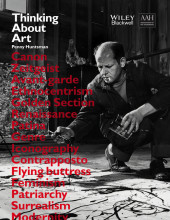Summary: Thinking About Art A Thematic Guide To Art History | 9781118905166 | Penny Huntsman
- This + 400k other summaries
- A unique study and practice tool
- Never study anything twice again
- Get the grades you hope for
- 100% sure, 100% understanding
Read the summary and the most important questions on Thinking About Art A Thematic Guide to Art History | 9781118905166 | Penny Huntsman
-
1 Genres and Subjects
-
What is the difference between genre and subject?
Genre is a bigger category of artworks (one of which is called "genre" itself), whereas the subject is what is more literally depicted in the artwork. -
1.1 Genres
-
What is the 'hierarchy of genres' and what is its order?
The hierarchy of genres was established by André Felibien and concerns the fact the more closely the artists recreates God's most perfect creation (humankind and its morality), the better his art is.
The order is as follows:
1. History.
2. Portraiture
3. Genre (daily lives)
4. Landscapes
5. Still lives -
1.1.1 History Genre
This is a preview. There are 1 more flashcards available for chapter 1.1.1
Show more cards here -
What is generally depicted in art works of the history genre?
These are istorias, which are historical, biblical or mythological narratives, and they depict acts of morality by noble figures from either history or mythology (including the Bible). -
How are people depicted in the history genre?
They were often nude and/or muscular in order to convey the perfection of God's creation and to show artistic skill. -
Where were artworks from the history genre generally displayed and what was their goal?
In large public spaces on just as large canvases, in order to reach their audience to the best of their abilities and elevate the viewers' morals with their scenes of heroism. -
What was the goal of David's The Oath of the Horatii and how is this achieved?
The goal was to support the French Revolution, which is done through the depiction of Roman patriotism in the three muscular men swearing on their swords. -
What is the point of paintings depicting mythology from Antiquity, such as Titian's Bacchus and Ariadne?
Again, to teach the viewers a lesson and to convey wealth. -
Apart from religious reasons, why were Biblical paintings such as Masaccio's The Tribute Money so popular within certain communities?
Because they were created to appeal to the audience, and in this case, the painting depicts taxes whereas the Florentines (where this was painted) were aggravated about having to pax taxes as well. -
Which three subjects broadly fall under the History genre?
1. Mythological stories.
2. Biblical stories.
3. Actual history. -
With which genre does the History genre often overlap?
Portraiture.
- Higher grades + faster learning
- Never study anything twice
- 100% sure, 100% understanding
Topics related to Summary: Thinking About Art A Thematic Guide To Art History
-
Genres and Subjects - Genres - Portraiture
-
Genres and Subjects - Genres - Genre
-
Genres and Subjects - Genres - Landscape
-
Genres and Subjects - Subjects - Religious subjects
-
Materials, Techniques and Processes - Painting: Timeless and Honoured
-
Materials, Techniques and Processes - Other media
-
Materials, Techniques and Processes - Sculpture
-
Materials, Techniques and Processes - Architecture
-
Form, Style and Function - The Beginning of Western Art - Classical Style
-
Form, Style and Function - Discovery of Antiquity and Development of Sacred Art
-
Form, Style and Function - A Move Towards Individualism
-
Form, Style and Function - New and Divergent Ways of Seeing in the Twentieth Century
-
Social and Historical Contexts
-
Patronage and the Social and Cultural Status of the Artist
-
Gender, Nationality and Ethnicity - Gender: The Representation and Subversion of Gender Stereotypes

































